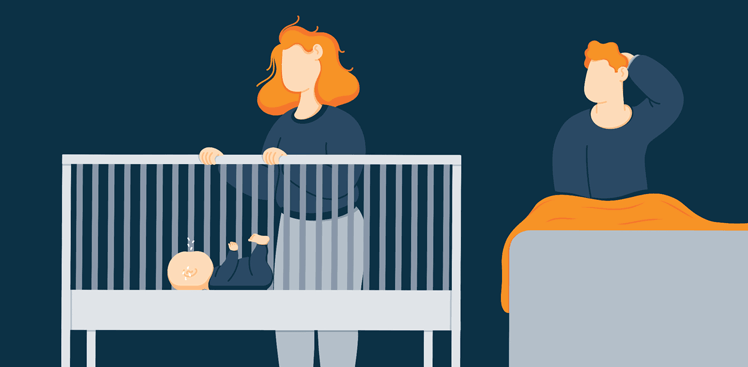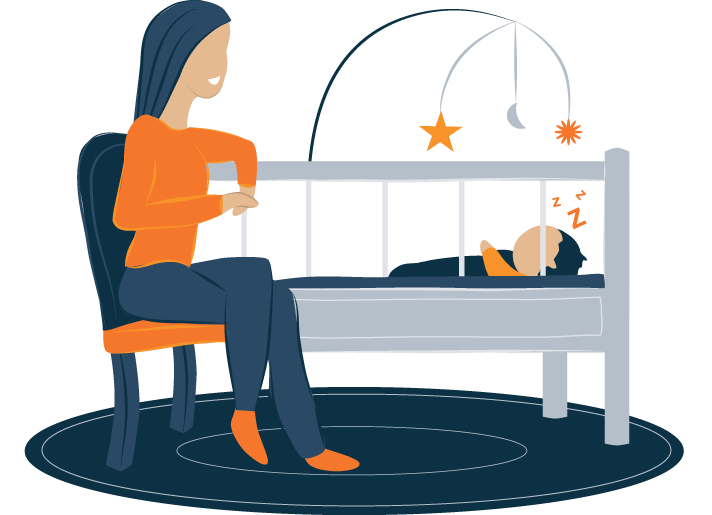Parents often come up with all sorts of creative solutions when their baby won’t sleep in their bed, from switching out the mattress to getting a whole new crib.
What some parents do not realize is the reason their little one is not sleeping at night has nothing to do with their mattress or crib. It is likely because your newborn has to adjust something about their lifestyle that they do not feel ready for yet.
Fear not, Mom and Dad—this article can help you find out why your baby hates the crib and offer solutions on how to make bedtime and naps in baby’s own bed a breeze.
Why Your Baby Doesn’t Like the Crib
They’re Not Used to It

If your little one has been sleeping in your bedroom and you’re transitioning him to his own room, there could be drama from your little one. He’s simply not used to the room, and it’s probably not as cozy as his previous arrangement.
You may have to make an effort to make his new bedroom feel like home and spend some time in there during the day, too. Use your baby’s room for playing, story time, singing, and cuddling sessions. If the room is a fun place to be, your baby should be happier spending time there. Just be sure to reserve the crib for sleeping.
They Don’t Know How to Sleep in It
Often, infants are used to falling asleep in mom’s arms while breastfeeding or with a bottle in their mouths. Or, they’re accustomed to being rocked to sleep and only placed in their bed when they’re already asleep.
While this behavior is okay during the first few months of a newborn’s life, these bedtime habits need to modified once your infant doesn’t need to be fed every couple of hours. However, it’s not always easy. Put yourself in your baby’s trendy moccasins: if you’re used to dozing off to warm snuggles, being laid down on a firm mattress without anyone to cuddle you is quite a transition!
Stomach Ache
Some babies are prone to acid reflux and colic. When you lie them on their back, they may feel incredibly uncomfortable. If you’ve ever had heartburn, you can relate.
Parents are Uncomfortable
Babies have an uncanny ability to sense stress and emotion in their caregivers. If you’re feeling trepidations or unease about putting your infant in a crib, then your little one is bound to feel some anxiety, too.
It Has Negative Associations
It’s easy to fall into this trap, but it’s not too late to make corrections. The negative associations happen when you use the crib as a timeout or a place to plop your child for a few minutes when you need five minutes of “mommy time” to go to the bathroom without a tiny human attached to your hip.
However, if the only thing your baby experiences in the crib is tears, then he’s likely not going to relish the idea of being placed in there for sleep.
Find Out More: Why Does Your Baby Cry When Put Down to Sleep?
The Crib is Too Wide
Though it might not seem like it to a grown adult, cribs are giant structures to a tiny human. Remember that your child has most likely gotten used to falling asleep in mom or dad’s arms, in a car seat, or in a swing. Being placed in what seems like an infinite and open space can feel disorienting, scary, and sterile.
Get Your Baby to Love the Crib
Try Swaddling
Parents have been swaddling babies since the dawn of time and for a good reason: it works. Wrapping your infant in a blanket and fashioning them into an adorable burrito is comforting for them.
It simulates the feeling of the womb, and it helps to suppress the Moro reflex, which wakes babies out of sleep because their hands jerk upward.
Pediatricians advise against swaddling after your infant can roll over on his own. Being constricted like that with a roll over onto the tummy can cause suffocation, increasing the risk of SIDS (sudden infant death syndrome).
Need help? Check out best rated swaddle blankets here.
Use a Sleep Sack
If your child is older than about four to six months old and is rolling over on his own, it’s likely time to graduate from a swaddle and use a sleep sack. Sleep sacks are similar to swaddle blankets, except they allow the arms to be free. This means that they can be used in a crib beyond the newborn and early infant stage.
View Our Guide: Top Rated Sleep Sacks
Use a Lovey
A lovey, sometimes called a transitional or comfort object, is a way to help your child sleep comfortably by having something to soothe him. It can be a stuffed animal, a pacifier, a special blanket, or even mom or dad’s t-shirt. Often one of a baby’s first loveys is a receiving blanket, though there are adorable loveys designed specifically for the purpose.
Make sure your child is at least four months old before introducing a lovey to prevent suffocation. You could also try having a baby monitor in the room so that you can see your baby at all times.
Want to see more? Visit our full guide to best security blankets.
Try a Baby Swing
Babies shouldn’t necessarily spend time sleeping in a swing, but it can be an invaluable tool for lulling them to sleep. Resist the temptation to let them sleep in there—especially without supervision—as it can increase the risk of SIDS, according to The American Academy of Pediatrics.
The trick to this tip is to move your baby from the swing to the crib just as their eyelids are beginning to droop.
Stick Around for a While
Just because you’re not spending the night in the nursery doesn’t mean that you can’t still provide comfort. As you begin to make this transition, feel free to stand by the crib, sing to your little one and stroke or pat them. As the days go by, you should spend less time in the room, and you can begin interacting with them from the doorway of the room.
This gradual transition gets your baby used to the idea of sleeping in their crib, and it gives them time to adjust to mom and dad not being by their side all night.
Put Your Scent Near Your Baby
Newborns are surprisingly skilled at sniffing out their parents’ scent. While you shouldn’t have anything additional in a crib with your newborn, you can tuck an old t-shirt or another piece of material that smells like you under a corner or edge of the crib mattress. Your little one might be able to reach and smell it without being able to pull it over their face.
Frequently Asked Questions
Is it safe for newborns?
Yes, this sleeping arrangement is safe for newborns, but there are some guidelines to keep in mind:
- Lie your infant on their back, not their tummy, even when they’re old enough to roll on their own. If baby rolls onto their tummy by themselves, you do not have to flip them over during the night.
- Until they’re about four to six months, avoid putting anything in bed with them that can pose a choking or suffocation risk. This includes stuffed animals, blankets, and crib bumpers.
- Get a video monitor so that you can see what’s going on in your little one’s room.
Looking for more info? Read our complete guide to safe sleep for babies.
Why does my baby not sleep in a crib anymore?
You might have had some initial success with this sleeping arrangement only to find that you regress weeks or months later. Consider what kinds of habits you may have inadvertently developed or take into account some other changes your infant may be going through. Here are some things to think about to get you started:
- Have you been using the crib as a place for timeout or a safe place to put your little one when you need a few minutes on your own?
- Are you only using the bedroom for sleep and nothing fun?
- Is your child used to falling asleep in your arms or while being fed?
- Are there other big changes happening in your life or your child’s? Are you pregnant, is your little one teething or has he begun to show signs of separation anxiety.
If your child has gone from sleeping successfully in their own bed to no longer enjoying it, one of these environmental factors could be at play.
Learn More: How to Get Your Newborn Baby to Sleep in a Crib
How to get baby to nap in a crib during the day?
Just like you want to prepare the room for sleep at night, similar arrangements should be made for naptime. These include:
- Keep the room dark or dim.
- Make sure the bedroom is relatively quiet. You can carry on conversations in the home but avoid vacuuming or other loud activities.
- Consider a white noise machine or soothing sounds if it helps your child fall asleep faster and sleep more soundly.
- Don’t forget to include a lovey. Loveys should be a part of the family, and even though your kid isn’t likely to be hanging on to a lovey during college years, it can be helpful to have one now.
Get More Info: How to Get Babies to Nap Longer?
Conclusion
The transition from the parents’ room or becoming accustomed to lax or unstructured sleeping habits can make it hard to train your child to sleep in his own crib. Once you’ve implemented these tips, you may be pleasantly surprised to find out that your child loves sleepy time or at least lets you put him in his crib with minimal drama.

Jill Zwarensteyn
Editor
About Author
Jill Zwarensteyn is the Editor for Sleep Advisor and a Certified Sleep Science Coach. She is enthusiastic about providing helpful and engaging information on all things sleep and wellness.
Combination Sleeper

